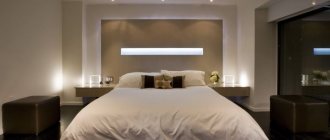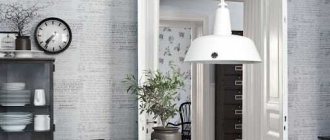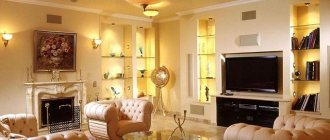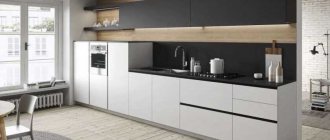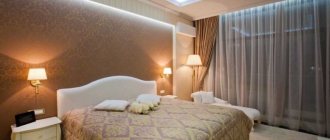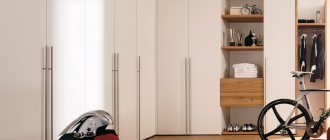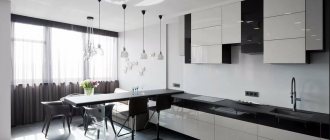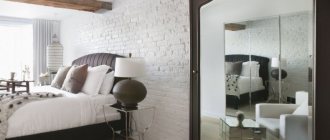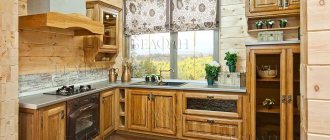Many people consider the kitchen to be the central place in the house. And this is no coincidence. After all, it is at the kitchen table that the whole family gathers to eat or just talk. Real housewives spend most of their time in the kitchen: they cook, clean, read, and do handicrafts.
Lighting in the kitchen cannot be ignored. That is why we have prepared an information article in which we will tell you about lamps, examples of lighting in different areas of the kitchen, and show photos of lighting in the kitchen.
Brief overview of the article
General lighting
When planning kitchen lighting, it is important to consider several factors: the arrangement of furniture, the number and placement of windows, and the purpose of each zone. Lighting is a combination of main light and additional light bulbs as backlight. Also, designers often place a floor lamp on a tripod in a modern interior.
Important: when organizing lighting, use natural window lighting wisely. To do this, do not cover the window openings with thick curtains. Give preference to light transparent tulles.
In a square room, you can use 1 central lamp, which should be located in the center of the room without a kitchen unit. If the kitchen is rectangular in shape, use several lamps, hanging them in accordance with the zoning.
If there are several zones in the kitchen, arrange for switches for each zone. It is not only convenient, but also economical.
Cold or warm?
We figured out the lighting points and types of lamps. All that remains is to choose light bulbs for our lamps, but even here it’s not so simple. It is known that sunlight is the most optimal for the human eye and perception. But, unfortunately, not a single light bulb manufacturer has yet been able to accurately recreate sunlight. Each lamp has its own color and light characteristics, which determine the perception of the interior as a whole. Let's try to figure them out.
Each lamp has 2 main parameters that you should pay attention to when purchasing. These are the color rendering index and color temperature .
Color rendering index
This indicator determines how adequately the color scheme of the interior will be perceived, that is, how much artificial lighting will distort it. On the packaging this indicator is marked with the letters CRI or Ra. The least distortion is produced by lamps with an indicator of 90-100. They should be chosen for lighting a small kitchen.
Colorful temperature
This parameter is responsible for the shade of light. It is marked on the packaging with the letter K. The color temperature varies from warm (2700K) to cold (6000K).
For residential premises, it is best to choose warm (2700-3000K) or neutral (4100K) light lamps. Cool light is more suitable for offices and other institutions, as it puts you in a working mood and promotes concentration.
Spot lighting
An important point is spot lighting of the work area in the kitchen. The work area includes a tabletop, which is used directly for cooking. You can use modern LED strips.
The sink and stove also cannot be left aside. When lighting a sink, it is important that the lamps are moisture resistant. To illuminate the stove, use the built-in lamp in the hood. They will definitely be ready for high temperatures.
Decorative lighting
This lighting is designed to create a certain decorative element in the interior of the kitchen. It will help give the room comfort, style, and zest.
Decorative lighting helps to visually increase the parameters of the room. For example, if you place an LED strip above a kitchen unit, the room will seem much higher.
In a dark room, to expand the space, you can stop at adding several sconces around the perimeter. In addition to light, they will add some zest to the kitchen design.
The interior lighting of frosted glass cabinets looks unusual, stylish and modern.
What to choose for which style?
After the main light sources have been sorted out, it’s worth talking about which ones will suit which style.
Country/Provence
The room should be bright and airy, the light should be soft and not glaring, not too intense. Lamps should be chosen with a warm tint, and lamps should be chosen in pastel shades of white, blue, pink, yellow. Motley and bright colors will not go well with such a kitchen. Chandeliers are chosen in interesting shapes, finished in bronze or silver, decorated with candles, stucco or flowers.
These styles welcome natural motifs, so it is better to choose lamps made of glass; plastic will not work, as will modern lighting systems such as spot systems and LED lamps. But sconces and table lamps are actively used.
Classic style
The classic style sticks to light colors, so the light should be bright, but soft. Typically, luxurious chandeliers with crystal or glass pendants are used as central lighting, and sconces, floor lamps and table lamps are used as lighting for functional areas.
The downside is that such lighting will require regular cleaning due to the accumulation of dust, so there are more and more kitchen designs in a classic style, but with LED strip lighting around the perimeter or spotlights along the walls.
The classic style loves symmetry, so there should be no question of how to position the spotlights - they are mounted symmetrically .
When choosing the main chandelier, you should focus on the scale of the room - everything should be proportional. In terms of color solutions, it is better to give preference to light tones; small bright details are acceptable.
Useful tips
- Lighting should be in harmony with the interior design. Remember that light design elements significantly expand the space, while dark ones make it smaller. A glossy ceiling is also used to enlarge the room. In small kitchen spaces, a small lamp will be enough, and in large ones, vice versa.
- If you use several lighting options in the kitchen, then they should be combined in a single style. Lamps that are not moisture resistant should be located at a distance of 60-70 centimeters from a sink with water.
- When choosing lamps with shades, give preference to options made of easy-to-clean materials.
- When choosing light bulbs for the work area, you can choose neutral or cool white light, and for the dining area, choose calm, warm colors.
It is necessary to think through lighting options in the kitchen interior along with its layout. Only in this case will you get the perfect kitchen of your dreams.
Types of lamps
After we have figured out the influence of the ceiling itself on lighting and the requirements for lamps, it’s time to move on to the lamps themselves. There are many different types, but the most popular, of course, are chandeliers, so they will be first on the list.
Chandeliers
From the very beginning, it is worth dividing chandeliers into ceiling and pendant ones. Ceiling - those chandeliers that we have become accustomed to since the times of the USSR, their height cannot be adjusted, they hang directly under the ceiling. Most often, their location is the center of the room, and their task is to illuminate the entire space.
Such a chandelier is attached to a special platform between the suspended and main ceilings, so you should think about the location in advance, and only then begin installing the canvas.
The pendants are hung on a dowel or hook to the original ceiling, and the cut in the ceiling is hidden with a special cover. Most often it is sold as a set with a chandelier, but it can also be purchased separately in hardware stores.
The suspension is convenient because it hangs on a wire, which means its height can be adjusted. For example, if the pendant acts as the main lamp in the center of the room, it will be higher than if it acts as additional lighting above the dining area.
You can hang several pendants side by side; it is not advisable to do this with ceiling chandeliers - it will look too massive, the ceiling will visually become lower and heavier.
Spot lighting
Spot lights are small, flat, fist-sized lights that look nice and attract attention. They have a small angle of illumination, so they are used in groups. This is absolutely safe, since diode bulbs are most often hidden inside, which do not heat up at all.
Another advantage of LED lamps is their efficiency: they consume much less energy than incandescent lamps, and last much longer - this is how their high cost pays off.
Such lamps have several more advantages:
- they are resistant to vibrations - they will not break or crack if an earthquake occurs, or the neighbor above decides to try out a new hammer drill on the floor;
- easy to maintain - it is practically not required, since the area of the lamp is too small;
- long service life - up to 4 years, then the light bulb is replaced.
There are two types of spotlights: movable and fixed. In mobile ones , you can direct a beam of light at a certain angle, but you will have to pay extra for such a function. Here it is worth considering whether you will really often change this direction of light, because to do this you will have to take a stool or stepladder, climb to the ceiling and adjust the lamp.
If there is not enough light, it is easier to buy an additional fixed spotlight and install it in the “dark” area.
Diode tape
Diode strip is a flexible plastic into which LED bulbs and resistors are inserted. Thanks to this device, the tape does not heat up at all, so it can be attached anywhere: even along a cornice with fabric curtains - there will be no fire. But most often the diode strip is placed around the perimeter of the room, at the bottom of the cabinet near the work area or at the junction of different types of ceilings, for example, plasterboard with tension.
However, it is not recommended to hang the tape in very damp rooms or near an open fire, as this will shorten the life of the lamp. But practice shows that this is an unnecessary precaution, since the diode strip is often located above the kitchen sink and work area. The service life is impressive - up to 15 years.
This is a budget option, since such a tape is inexpensive and consumes little energy. But it cannot be made the main method of lighting, since there will not be enough light with conventional placement options. Attaching this lamp is very easy - you only need double tape.
But there is one drawback that many people turn a blind eye to: if one light bulb goes out, you will have to change the entire strip, because the lamp cannot be replaced individually. But one light bulb does not greatly affect the degree of illumination, so this is more of an aesthetic problem.
Spot system
A spot system is a rod or rail on which several lamps are located. Such systems are very diverse, for example, a tire can move, bend, that is, it can be given different shapes , making the lighting convenient and unique.
The lamps themselves can be static, or they can move along a rod or rail. In addition, they can move left and right, changing the direction of their light.
Such lamps are suitable for both small and large kitchens. Only if on the first the spot system will play the role of the main lighting, then on the second it will most likely be additional light for the dining or work area.
There are stylistic restrictions. It is clear that a spot system is inappropriate in a classic kitchen, but in rooms in fashionable urban styles it will look very organic. For example, hi-tech, loft, minimalism, modern and so on.
LED lamps
LED lamps are not yet popular in our country, but their popularity should be increased. As the name implies, they are based on LED lamps (sometimes called LED lamps). A special feature is their appearance: most often it is a square or circle that completely glows. Sometimes they are called soft boxes.
The advantage is that the soft box gives a very beautiful and soft light , which makes the room more spacious. Most often, LED lamps are used as the main light source; if the room is small, then they are the only one.
Since they are based on LED lamps, their advantages can also be attributed to the soft box:
- does not heat up;
- consumes little electricity;
- serves for a long time.
Due to the fact that the kitchen is a room with high humidity, you need to choose models with a 12-volt power supply and a transformer. The downside of such lamps is the cost. Some models can change the color and brightness of the light, which has an additional impact on the price.
Lamps for suspended ceilings - design options
